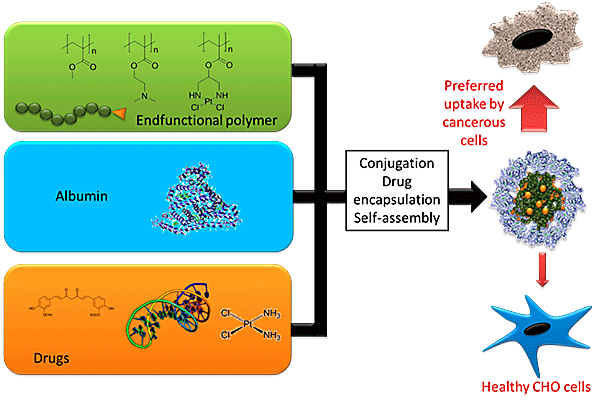Polymers for Health 4
Protein-coated micelles to treat cancer
Investigator:
Prof Martina Stenzel
Abraxane©, is an injectable formulation of paclitaxel where the drug is bound to albumin as a delivery vehicle (nab technology). This is one of the few nano-formulations that have made it on the market today. The secret of this technology developed by Desai and co-workers lies within the simplicity of the approach while being highly effective during treatment of cancer. Albumin belongs a family of water soluble protein comprising three homologous domains which assemble to form a heart shaped molecule. Serum albumin is the most abundant protein in blood plasma and the specific types include human serum albumin and bovine serum albumin. Human serum albumin is a relatively small protein which is produced in the liver and occurs in the bloodstream with a concentration of about 50 mg/mL. This characteristic coupled with its high concentration throughout the body has led to its use as a very safe, highly immunogenic protein for the transport of toxic drugs through the bloodstream. Processing many albumin molecules into nanoparticles represents a quantum leap in performance since additional accumulation of the drug in the tumour site was caused by the enhanced permeation retention (EPR) effect. This is the origin of the success of Abraxane©. The albumin technology has so far been tested on a range of drugs and has been reviewed in detail elsewhere. However, the driving force of nanoparticle formation is the presence of hydrophobic drug molecules which act like glue holding the albumin molecules in place. More hydrophilic drug molecules and charged drugs like nucleic acids are therefore not suitable for this technique.
In order to modify albumin without affecting its bioactivity, one method is to only modify one amino acid as it has been done in the past 40 years. Conjugation of hydrophobic polymer chain is a less explored pathway resulting in biohybrid amphiphiles with a hydrophilic protein head group conjugated to a hydrophobic polymer tail which self-assembles to form micelles in water. Certain polymerisation techniques have been used to synthesise spherical protein-polymer micelle aggregates as small as 30-70 nm. In addition, they can be formed in-situ during the polymerization of the hydrophobic monomer. The synthesis of a well-defined biohybrid amphiphile requires precise control over both the protein/polymer ratio and the site at which the protein is modified. Finally, it is important to preserve the original activity of the protein, and this site-specific anchoring of polymer to the surface of the protein can be realized by methods such as covalent coupling or non-covalent binding to a single reactive surface moiety.
In our lab, we have developed a range of protein-based carriers that are hybrids between synthetic polymers and proteins. These drug carriers are tailored to be suitable as a vehicle for any kind of drugs including traditional hydrophobic drugs, DNA, and metal-based drugs.

Figure: Design of albumin coated micelles for the delivery of various drugs
